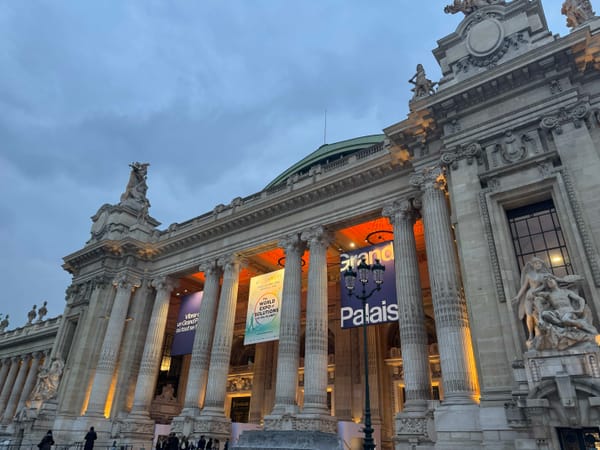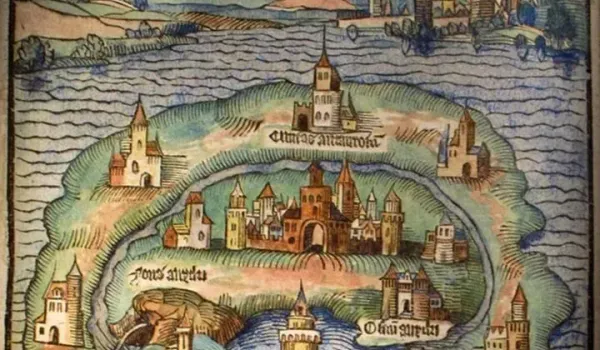Dante and the Relational Nature of the Soul
The multidimensional audacity of Divina Commedia is well established. A Christo-classical epic, written in the vernacular, chockablock with timely political commentary woven into theological exploration. Dante does not leave a single color untouched on his palette...

The multidimensional audacity of Divina Commedia is well established. A Christo-classical epic, written in the vernacular, chockablock with timely political commentary woven into theological exploration. Dante does not leave a single color untouched on his palette, painting his story with characters from every age and era of history and myth. Just as he blends the contemporary and the mythical, he blends the theological and the material, the metaphysical and the physical. Every sort of reality is presented in the Commedia in some form or fashion, because Dante knows that to approach to the heart of being requires a multidisciplinary approach. The capital-T Truth of life, the universe, and everything can’t be found by any one path alone, and perhaps cannot even be fully realized by mortal minds, but that summit must still be attempted. If we cannot reach the solution to the great question of life, then the next best thing is to develop abstractions, like rendering a three-dimensional cube with six lines on a two-dimensional sheet of paper. Whether truly divine or simply mundane hallucination, Dante’s inspiration was indisputably profound, giving him a complex vision into the heart of reality that he then had to translate onto the page. We the reader are left with the two-dimensional representation. Our challenge is to transpose Dante’s concepts back into their fully realized form from that reduction. While Dante’s vision of the theological and moral landscape of reality is infinitely more complex than a six-sided cube, thankfully, so is his rendition of that vision. By presenting his lessons on the nature of the soul via multiple teachers from multiple eras of history, Dante lets the meta-history of their respective backgrounds contribute to the larger narrative and logical argument that he is making throughout la Commedia.
As Dante walks the third terrace, he finds the souls afflicted by anger, surrounded by horrible thick black smoke. They sing the Agnus Dei, praying aloud and surely choking on the vapors in penance. Dante finds Marco Lombardo among them, who readily confesses his sins and asks for help. “I was a Lombard and I was called Marco; I knew the world’s ways, and I loved those goods for which the bows of all men now grow slack… I pray you to pray for me when you’re above” (Dante XVI 46-48). Dante agrees and asks him a simple question to keep the conversation going: Who stripped virtue from the world? We can imagine Lombardo shaking his head in disappointment. This silly living man asks if the fall originated from heaven or hell, and disregards humanity’s role! “You living ones continue to assign to heaven every cause, as if it were the necessary source of every motion. If this were so, then your free will would be destroyed, and there would be no equity in joy for doing good, in grief for evil” (XVI 67-72). This is a beautiful phrase, capturing the deterministic arguments of the world and dismantling them in equal turn, and is the first of many places in these verses where Dante (the writer) captures insights so fundamental, they reappear throughout the world’s wisdom. Iain McGilchrist, a British psychiatrist whose groundbreaking work blends neuroscience with epistemology and physics, wrote the following in his latest work, The Matter with Things: “At the core of the contemporary world is the reductionist view that we are— nature is — the earth is— ‘nothing but’ a bundle of senseless particles, pointlessly, helplessly, mindlessly, colliding in a predictable fashion, whose existence is purely material, and whose only value is utility… And with the reductionist outlook goes determinism, the belief that if we knew enough about the position and momentum of every particle in the universe we could predict everything that happens from here on in, including your every thought, desire, and belief” (McGilchrist 5). He continues to argue that these sorts of worldviews which perceive everything in the universe as “things” are fundamentally flawed because we do not live in a universe of discrete objects isolated from one another. We live in the context of the world around us, in reciprocal relationships that define who and what we are, and by participating in this reality, we help to create it. Sound familiar? Replace McGilchrist’s senseless particles with heaven, and he’s making the same argument as Lombardo nearly a millennium later!
Our individual souls are at the heart of the problem, those selfish urges that drive us more often than we care to admit and occlude our recognition of the relational nature of reality. “Thus, if the present world has gone astray, in you is the cause, in you it’s to be sought” (XVI, 82-83). Lombardo pursues that facet of the soul to its root next: “Issuing from His hands, the soul, — on which he thought with love before creating it— is like a child who weeps and laughs in sport; that soul is simple, unaware; but since a joyful Maker gave it motion, it turns willingly to things that bring it delight” (XVI, 85-90). I say again, what a beautiful phrase! Like flowers on the forest floor striving for sunlight, we are naturally compelled to pursue delight. However, that pursuit can be easily lead down a dark path as harmful or negative things are easily pursued in the name of delight. Humans crave salt, fat, and sugar, and we need them in some amount, but with our inclination to pursue the unlimited joy of Heaven, we lack built-in self-restraint. This results in the consumption of McDonald’s and subsequently, the corruption of the world. “At first it savors trivial goods; these would beguile the soul, and it runs after them unless there’s guide or rein to rule its love” (XVI, 91-93). The root of sin is the free will of an imperfect people intrinsically oriented towards good. “The wanting infected the earth” (Harjo 9).
Yet again, Dante touches upon the universal fundament. In Buddhist circles, this same instinct towards immediate fulfillment of joy is often referred to as the grasping mind. As the Tibetan master Yongey Mingyur Rinpoche wrote: “Ego is not an object, it’s more like a process that follows through on the proclivity for grasping and for holding on to fixed ideas and identities” (Rinpoche 39). We come full circle, by the way. A Buddhist, a psychiatrist, and a Florentine in exile have all walked into a bar and alluded to the relational nature of reality as a series of processes rather than things. Another example, from Blackfoot Physics: “Several leading-edge thinkers in physics suggest that nature is not a collection of objects in interaction but is a flux of processes. The whole notion of flux and process is fundamental to the Indigenous sciences of Turtle Island. Algonkian-speaking peoples, such as the Cheyenne, Cree, Ojibwa, Mic Maq, and Blackfoot all share a strongly verb-based family of languages that reflects this direct experience” (Peat 7).
Having completed the lesson from Lombardo, Dante moves on and Virgil returns to the lectern. Where Lombardo’s lecture was rooted in a combination of reason and faith, as the representative of the wisdom of Dante’s own age, Virgil will focus entirely on logic. “What reason can see here, I can impart; past that, for truth of faith, it’s Beatrice alone you must await” (XVIII 46-48). Lombardo provided the final thesis up front, his argument rooted in both practices. Now, Virgil (and later in Paradise, Beatrice) will provide the supporting evidence distinguished by their own respective camps. Author-Dante is acting geometrically here, building the proof of his argument step by step.
Where Lombardo spoke of heaven and God, Virgil focuses on the classically recognized elements of the question at hand: the soul and love. “The soul, which is created quick to love, responds to everything that pleases, just as soon as beauty wakens it to act. Your apprehension draws an image from a real object and expands upon that object until soul has turned toward it; and if, so turned, the soul tends steadfastly, then that propensity is love— it’s nature that joins the soul in you, anew, through beauty” (XVIII, 19-27). Interactions between the soul and the physical world are at the heart of nature. Thus the sort of interactions we employ our will towards are absolutely crucial. Yet another insight echoing through the ages to McGilchrist: “Attention is not just another ‘cognitive function’: it is, as I say, the disposition adopted by one’s consciousness towards the world. Absent, present, detached, enraged, alienated, empathic, broad or narrow, sustained or piecemeal, it therefore has the power to alter whatever it meets. Since our consciousness plays some part in what comes into being, the play of attention can both create and destroy, but it never leaves its object unchanged. So how you attend to something — or don’t attend to it — matters a very great deal” (McGilchrist 21). The soul, Virgil says, is an element of nature, “just as flames ascend because the form of fire was fashioned to fly upward, towards the stuff of its own sphere, where it lasts longest, so does the soul, when seized, move into longing, a motion of the spirit, never resting till the beloved thing has made it joyous” (XVIII 28-33). On its face, the argument that the soul is a natural element can seem antiquated to modern sensibilities. We cannot measure the soul like a particle, or observe it like lightning. Nature is external to the observer, right?
The physicist John Wheeler, who studied with Niels Bohr and taught Richard Feynman at Princeton, gave both black holes and wormholes their names. He was determined to find the fundamental units of reality, what he referred to as “pregeometry”, and he chased that topic for much of his career. As he peeled back the layers of physics, he reached a point where only one principle remained. “Quantum mechanics, he wrote, ‘destroys the concept of the world as ‘sitting out there,’ with the observer safely separated from it by a 20 centimeter slab of plate glass. Even to observe so miniscule an object as an electron, he must shatter the glass. He must reach in. … The universe will never afterwards be the same. To describe what has happened, one has to cross out that old word ‘observer’ and put in its place the new word ‘participator.’ In some strange sense the universe is a participatory universe’” (Gefter). We live in a relational world, one where our souls’ interaction with nature changes both parties. This has been known, in some form or another, since the classical era. The impact of participation isn’t just theoretical, though. It’s an observed phenomenon. “[Wheeler] had been thinking about the double-slit experiment, the infamously brain-melting proof that our commonsense expectations about the workings of the world can’t hold. Particles such as photons are sent through a screen with two slits before hitting a photographic plate on the other side. When both slits are open, the photons one by one build up an interference pattern on the plate, as if each photon had gone through both slits, wavelike, interfering with itself. But if we measure which slit a photon passes through, that interference pattern disappears. What we choose to measure matters. He had been thinking about the double-slit experiment, the infamously brain-melting proof that our commonsense expectations about the workings of the world can’t hold. Particles such as photons are sent through a screen with two slits before hitting a photographic plate on the other side. When both slits are open, the photons one by one build up an interference pattern on the plate, as if each photon had gone through both slits, wavelike, interfering with itself. But if we measure which slit a photon passes through, that interference pattern disappears. What we choose to measure matters” (Gefter).
Dante had no possible framework for understanding what a photon was, but I doubt he’d be surprised by these findings if a time-traveler patiently explained them to him. Centuries ago, he recognized the operating principle of participation, and perhaps grasped it more securely than Professor Wheeler. Though Wheeler felt confident that “we weave the fabric of the universe out of billions upon billions of acts of observer-participancy”, questions remained around the nature of that fabric (Gefter). If every act of participation creates its own little piece of reality, what governs the entire thing? He was haunted by what he referred to as the ten thousand tinsmiths: “Observers independently participating … like 10,000 tinsmiths hammering away independently at 10,000 separate tasks,” he wrote in his journal. Why don’t they create 10,000 separate space-times? “What troubles me more than anything else is how different observers combine their impressions to build up what we call reality” (Gefter). Wheeler, like Virgil, operates from a place of reason, not faith. What Dante recognized and tried to capture through his use of multiple teachers is that necessary blend of reason and faith. Individual intention and attention are inherent properties of nature, but they sit upon the vast intention and attention of God. “Communion with God and communion with others are realizations of the same Center. And this Center, according to the ancient definition, is everywhere. ‘God is that reality whose centre is everywhere and whose circumference is nowhere’” (Laird 12).
That leap from reason to faith is the treasure of Dante, the reassurance that we individuals are just that: individual. Free to make our own choices, to pursue what we wish and what brings us joy. Yet regardless of what corner of reality we participate within, we do not do so alone. There is a deeper attention beneath our reality, something intertwined with the infinite processes that compose space and time themselves, and we are a part of that attention. “Union with God is not something to be acquired but realized. The reality, which the term ‘union’ points to… is already the case. The unfolding in our lives of this fundamental union is what St. John of the Cross called ‘the union of likeness’. It is our journey from image to likeness (Gen 1:26)” (Laird 10). Whether your interpretation of God is Catholic or Buddhist or nothing at all, the undeniable truth is that we do not walk through life in isolation, and our connections and our choices are what give life meaning. “I got a vision of myself… hung up in a great endless universe with nothing overhead and nothing under but the Infinite Nothingness, the Enourmousness of it, the dead without number in all directions of existence whether inward into the atom-worlds of your own body or outward to the universe which may only be one atom in the infinity of atom-worlds and each atom-world only a figure of speech — inward, outward, up and down, nothing but emptiness and divine majesty and silence” (Kerouac 33).
By framing these lessons as conversations within the context of his greater epic, Dante leaves behind a much greater footprint on the mind than he would have by simply writing up his points in a memo. “To put the matter in a nutshell, a philosophical argument does more and does less than a logical one: less in that it never establishes anything conclusively; more in that, if successful, it is not content to establish just one isolated point of truth, but effects a change in our whole mental outlook so that, as a result of that, myriads of such little points are brought into view, or turned out of sight, as the case may be” (Waisman, via McGilchrist, 6). Consider where these arguments are placed in the hierarchy of the afterlife. By placing Virgil and Marco Lombardo’s lessons in Purgatory, Dante shows the importance of faith and a relationship with God. Faith and reason combined get you to Paradise, like Beatrice. Without faith, you’re left in Purgatory. “Reason, even when supported by senses, has short wings” (Paradiso II 56-57). Lombardo is praying to God, asking Dante to pray on his behalf, because he recognizes what he lacks in order to reach Paradise. Without faith or reason, you’re left in the Inferno. These conversations could not have happened in the place of torment and they are not needed in the place of rejoicing, therefore they must happen in the place of atonement. The deepest, most desired joy is that of life in Heaven and God’s light. To reach it, a soul must understand itself. Γνῶθι σαυτόν. Know Thyself. Like Virgil, that commandment predates Christianity, yet it rings universally true.
Works Cited
Dante Alighieri, and Allen Mandelbaum. The Divine Comedy of Dante Alighieri. Purgatorio. Bantam Books, 2004.
Dante Alighieri, and Allen Mandelbaum. The Divine Comedy of Dante Alighieri. Paradiso. Bantam Books, 2004.
Gefter, Amanda. “John Wheeler Saw the Tear in Reality.” Quanta Magazine, Quanta, 25 Sept. 2024, www.quantamagazine.org/john-wheeler-saw-the-tear-in-reality-20240925/.
Harjo, Joy. Conflict Resolution for Holy Beings: Poems. W.W. Norton & Company, 2017.
Kerouac, Jack. Lonesome Traveler. Penguin Books, 2000.
Laird, M. S. Into the Silent Land: A Guide to the Christian Practice of Contemplation. Oxford University Press, 2006.
McGilchrist, Iain. The Matter with Things: Our Brains, Our Delusions, and the Unmaking of the World. Volume 1: The Ways To Truth, Perspectiva Press, 2021.
Rinpoche, Yongey Mingyur, and Helen Tworkov. In Love with the World: A Monk’s Journey through the Bardos of Living and Dying. Random House, 2021.





